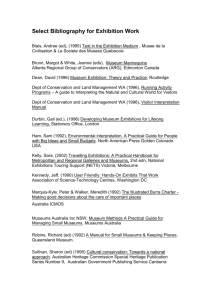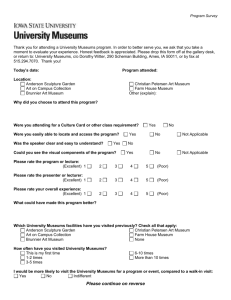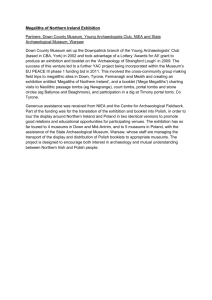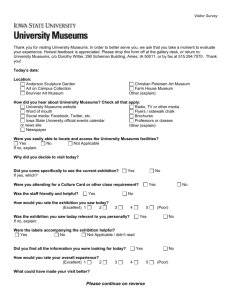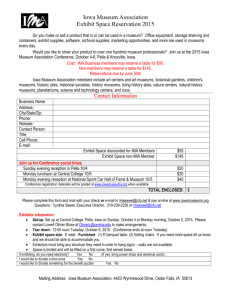Interpretations - University Museums
advertisement
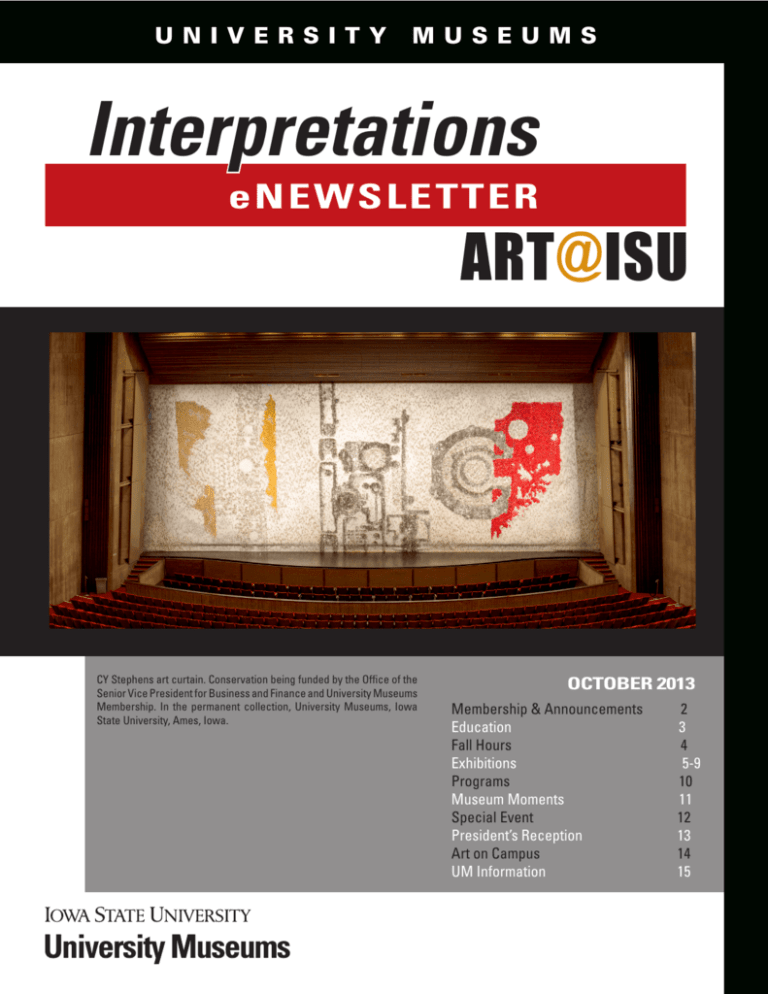
UN I V E RSITY MUSEUMS Interpretations eNEWSL ETTER ART@ISU CY Stephens art curtain. Conservation being funded by the Office of the Senior Vice President for Business and Finance and University Museums Membership. In the permanent collection, University Museums, Iowa State University, Ames, Iowa. OCTOBER 2013 Membership & Announcements 2 Education 3 Fall Hours 4 Exhibitions 5-9 Programs 10 Museum Moments 11 Special Event 12 President’s Reception13 Art on Campus14 UM Information15 M E M B ERSH I P & ANNOUNC EMENTS 2013-2014 Annual Membership Drive Underway Have you renewed your membership? Memberships are critical to the University Museums by helping to fund projects, education programs, exhibitions, staff, conservation and collections care. This funding is critical to the annual operations of your University Museums. Keep in mind, memberships are tax deductible. Consider renewing your membership or joining us for the first time. With the holidays just around the corner, remember that memberships also make wonderful gifts for friends, family, and ISU students! Questions about Membership should be directed to Sue Olson, 515-294-3342 or sdolson@iastate.edu. NEW & NOTEWORTHY Design 230 students study “Introduction to Design Thinking” with curator Adrienne Gennett in the Brunnier Art Museum using permanent collection objects. Pohlman to Receive Regents Award for Staff Excellence Faculty and staff recipients of the university’s most distinguished awards will be honored Wednesday, Oct. 2, 2013. University Museums director and chief curator, Lynette Pohlman, will receive the Regents Award for Staff Excellence. The award is presented by the Board of Regents to recognize members of the Professional and Scientific staff who are outstanding university citizens and who have rendered significant service to the university or the state of Iowa. Pohlman’s nomination states: “Lynette Pohlman has brought joy, beauty and culture to almost every corner of the campus. She has guided the university toward building and displaying a world-class art collection; built bridges that link people around the world with Iowa State through its art; and she has done all of this with exemplary skill, enthusiasm, loyalty and pride in the university and community for the past 32 years.” Recent Installation at Curtiss Hall Corinne Ulmann’s installation of glass panels at the Harl Commons in Curtiss Hall was completed over the September 21st weekend. The as yet untitled work of art was fabricated in Germany and consists of fused and painted glass. The railing panels, when viewed from the ground floor of the Harl Commons create a landscape reminiscent of Iowa. 2 EDUC ATION University Museums Staff Teaches Osher Lifelong Learning Institute Classes This semester University Museums has partnered with the Osher Lifelong Learning Institute to offer new classes to OLLI students. In September, Nancy Girard, Educator of Visual Literacy and Learning led a course called “How to Read a Work of Art.” Participants explored the Permanent Collection, looking at everything from abstract sculpture to figurative paintings. Using visual literacy and learning techniques, they discussed the art at ISU and discovered what we can learn from looking. Studies show that by becoming more visually literate, you’ll learn how to think more effectively. Critical thinking, communication, and evidential reasoning skills all increase with practice. Two of the participants shared their experience. Visual Literacy opened my eyes to new ways of engaging with art. Previously I would interpret art before I even took time to describe the piece to myself. Now I see the value of the first step; description, followed by interpretation, and finally evaluation. Nancy lead me through some meaningful and fun exercises that illustrated these steps perfectly.I especially appreciated looking at some of the art work in the ISU public art collection as the means to practice these techniques. – Cindy Scholten I doubt if my experience was typical, since I had considerable 'instruction' on the Wyeth painting prior to the class. But it was interesting, trying to talk just about the objects in the painting without interpreting their meaning. I guess you can learn more about a subject, even if you think you know it well. But I had never really noticed the shadow before, let alone what it adumbrated. – Art Klein This month, Adrienne Gennett, Assistant Curator of Collections and Education will lead a two part course titled, “The Science of Decorative Arts.” The class will meet in the Brunnier Art Museum, 295 Scheman on Tuesdays, October 1 and 8. This course will explore both the science and artistry found in ceramics and glass within the decorative arts. Utilizing the new decorative arts gallery at the Brunnier Art Museum, the course will examine both of these mediums and the scientific discoveries used in the creation of these diverse objects. This will include an examination of the history of ceramics and glass in the decorative arts through the objects on view in the exhibition, along with the broader understanding of the mediums. For more information on OLLI and the courses offered, visit their website: http://www.isualum.org/index.cfm?nodeID=9479&audienceID=1 Artistry in Wood Course Offered Beginning in October, University Museums will be co-teaching a class with the Natural Resource Ecology and Management Department called Artistry in Wood, NREM 181x. Co-instructors are Douglas Stokke, Ph.D., Senior Lecturer, NREM, and Nancy Girard, M.A., Educator of Visual Literacy and Learning This course is a survey of the artistry of wood as appreciated in spatial scale from microscopic anatomy to engineered wood structures. Anatomical and physical properties that render wood as a medium for artistic expression. The works of local artists, designers and engineers will be featured. The University Museums collection and Art on Campus will be explored. Specific Course Student Learning Outcomes: 1. Appreciate basic anatomical features of wood. Observe the beauty of wood at microscopic and macroscopic scales. 2. Learn of the historic significance of wood as a medium for artistic expression and as a vehicle for “wood culture” around the world. 3. Develop an appreciation of the visual and tactile cues that impart a sense of enjoyment of wood in various contexts. 4. Become aware of opportunities for life enrichment through University Museums patronage. 5. Cultivate visual literacy skills: Analysis, interpretation, description and evaluation. 3 HOUR S Enjoy the newest additions to the Art on Campus Collection? Have a favorite work of art on campus? Tag your photos with #ISUPublicArt on social media. Share the works of art that you discover on ISU campus with us. Be creative like this shot of Ripple by Ann Gardner in Troxel Hall - captured by laying on the floor and looking up. University Museums, Iowa State University ISU_Museums FALL HOURS #ISUP ublicArt FA LL Brunnier Art Museum, 295 Scheman Bldg. Tuesday - Friday 11:00 AM - 4:00 PM, Saturday - Sunday 1:00 PM - 4:00 PM Closed Nov. 28 - Dec. 1 Closed Dec. 21 - Jan. 12, 2014 Christian Petersen Art Museum, 1017 Morrill Hall Monday-Friday 11:00 AM - 4:00 PM Closed November 25-29 Closed Dec. 21 - Jan. 12, 2014 Farm House Museum, central campus Monday-Friday Noon - 4:00 PM Closed November 25-29 Closed Dec. 21 - Jan. 12, 2014 For more information or to schedule a tour call 515.294.3342 4 EXHIBITIONS BRUNNIER ART MUSEUM EXHIBITIONS Now through December 20, 2013 In Pursuit of Wildlife Conservation: The Art of Jay N. Darling and Maynard Reece The fine art prints of Jay N. Darling (1876-1962) and oil paintings of Maynard Reece (b. 1920) explore the mutual interests of wildlife conservation. At age nineteen, aspiring artist Maynard Reece was introduced to Jay N. Darling, Pulitzer Prize winning, syndicated cartoonist; nationally acclaimed conservationist, and fine artist. Darling soon became Reece’s aesthetic mentor commenting on the younger artist’s images of wildlife and native landscapes. They became colleagues and friends for the next twenty three years. Darling’s images, both cartoon and etchings became the conscience of conservation for over half a century. While Darling has many legacies, one of his most enduring was the development, creation and implantation of the Federal Duck Stamp Program in 1934 under the U.S. Biological Survey (now the United States Fish and Wildlife Service), that was and remains directed towards wetland refuges for wildlife were millions of acres have been rescued, restored and preserved. Beginning in 1948, Maynard Reece has won five of the Federal Duck Stamp competitions in 1951, 1959, 1969, 1971, more than any other artist. Reece’s art has been published in many national magazines, and his oil paintings are prized by collectors. The exhibition includes 75 etchings by Jay N. Darling, including Darling’s original 1934 Federal Duck Stamp and etching, and 48 works of art by Maynard Reece, including the five paintings for the Federal Duck Stamps, and a newly commissioned painting to commemorate the ReeceDarling relationship with wildlife conservation. The exhibition is organized by the University Museums with participation of Maynard, Carolyn and Brad Reece. Exhibition support is generously provided by Harold and Rachel Crawford, Clifford Smith, Linda and Willis M. Bywater, Peter Orazem and Patricia Cotter, Christopher Koss, Fred and Ruth Kammeier, Ralph and Charlotte Schlenker Charitable Trust, Donna Howard, Mary Ellen and Don Wishart, Betty and Dennis Keeney, the Office of the President, the Office of the Senior Vice President for Business and Finance, and University Museums Membership. The Hunt: Selections from the Decorative Arts Collection This exhibition explores the use of the hunt as a popular source for imagery in the decorative arts during the 18th, 19th, and 20th centuries. Sporting art as a genre became increasingly popular in the 18th century, building upon a tradition that had existed for centuries. In Western Europe the paintings and prints of hunting imagery found their way into the decorative arts. 18th century porcelain painters readily adapted these hunting scenes to their forms and in Bohemia this imagery found its way onto delicately engraved glassware, where entire scenes of the hunt were depicted in great detail. The English developed a prominent tradition of sporting arts in the 18th and 19th centuries and the popularity of this art form amongst the common and aristocratic man would translate to the decorative arts over time. The sporting arts also grew in popularity in America in the 19th century, as hunting began to be viewed positively as way to return to the patriotic and virtuous ways of life of the country’s founding fathers. The long tradition of hunting throughout the world, originally born out of necessity, but transformed into an exercise in physical ability and social activity for all levels of society, led to the popularity of its imagery in the realm of the decorative arts. The exhibition is curated by Adrienne Gennett, University Museums and is supported by Martha Allen, and the University Museums Membership. 5 EXHIBITIONS Ceramic Tradition I Contemporary Design Traditional methods of decoration influence many contemporary ceramicists today, who continue to experiment with glazes and decorative motifs. They are building upon the discoveries of the past to create completely new works of art. These works are linked to the past and the great inspiration that can be found in the use of tradition. By displaying ancient and historic wares with contemporary ceramics, this connection with the past can be explored by the viewer, who will come to understand the enduring inspiration of the past. The exhibition is co-curated by Adrienne Gennett and Ingrid Lilligren from the permanent collection and the collection of Ingrid Lilligren. This exhibition is supported by the University Museums Membership. Ann’s Glass The Brunnier Art Museum would not be in existence were it not for the love of collecting that inspired Ann Brunnier to constantly seek out objects of beauty to add to her collection of the decorative arts. As she traveled the world with her husband Henry Brunnier, she amassed an exceptionally diverse range of decorative arts objects, spanning from ancient Egypt and Rome to the 20th century and in all materials. This inaugural exhibition of the collection of Ann and Henry Brunnier focuses on their glass. The diversity of Ann’s taste is especially apparent in the glass she collected, which includes magnificent examples of Roman glass from the turn of the first millennium to masterpieces of American art glass from the late 19th and early 20th century. The Brunnier Art Museum continues to maintain the legacy of the Brunnier’s, through exhibitions focusing on the decorative arts and also to recognize the passion that inspired Ann Brunnier to collect and later donate her superb collection that would create the Brunnier Art Museum. French Art Nouveau: Cameo Glass from the Permanent Collection The decorative arts were a principal component of the Art Nouveau movement which flourished in the latter half of the 19th century. Practicing artists were concerned about the loss of craftsmanship, which was a consequence of the industrialization of the European continent. Decorative arts provided an opportunity for artists to combine function with the flowing botanical forms which were the hallmark of the style. Glass was ideally suited to this purpose because of its inherently plastic nature which was readily worked into sinuous natural shapes. This exhibition presents a selection of French cameo glass and tapestry that illustrates a variety of imagery, symbolism, techniques and forms favored by Art Nouveau artists. These objects express the preciousness, richness and opulence of the Art Nouveau movement. Included are objects by Émile Gallé (and his glass studio), who popularized 19th century cameo glass. This exhibition, located in the south entry of the Brunnier Art Museum, is curated primarily from the Ann and Henry Brunnier and Helen and Rex Cook collections. The Age of Brilliance The Age of Brilliance presents glass objects from the Brilliant Period in American glass (1876-1914). In 1876, the Brilliant Period began when eight American glass companies exhibited their newly created patterns of geometric designs at the 1876 Centennial Exposition in Philadelphia, thus captivating the nation’s attention. Created by craftsmen and artisans, brilliant cut glass is decorated entirely by hand using a rotating stone or metal wheel, holding the clear, smooth glass blank against these wheels to cut a predetermined geometric pattern in the surface of the glass. Immediately, cut glass objects became symbolic of social status and refinement, and were acquired by the privileged and the middle class seeking social advancement. This exhibition, located in the north entry of the Brunnier Art Museum, is curated primarily from the Ann and Henry Brunnier Collection, the Iowa Quester Glass Collection and the Helen Cook Glass Collection. 6 EXHIBITIONS HOT and COOL: Three Generations of Gaffers The studio art glass movement of the late 20th century stimulated a fresh interpretation of an ancient substance. Fifty years and three generations later, the glass art movement has provided a stunning array of artistic creativity that transcends glass from utilitarian functions and mass production to a medium of expressive fine art. The term studio glass refers to a singular, unique work of art created in a workshop in which usually one person, a gaffer, conceives of or directs assistants in the production of art. Studio glass is the antithesis of industrial glass, which is mass produced according to rigidly controlled standards that maintains conformity. The studio glass movement is one of the broader international craft movements that have flourished in the industrialized world since the 1960s. The premise of the craft movement, and more specifically the studio glass movement is clear, art is defined by its concept and content, and not its material. Studio glass sculpture emerged in the early 1960s with the experimentation in hot glass by artistic pioneers Harvey K. Littleton (American, b. 1922) and Dominic Labino (American, 1910-1987). In the 1970s, Dale Chihuly began to popularize the studio glass sculpture movement. After studying at U of W – Madison with Littleton, Chihuly established his own glass program at the Rhode Island School of Design. In 1971, he co-founded the Pilchuck Glass School in the Seattle, WA area. Examples of Chihuly’s early glass sculptures and those of his students, Sonja Blomdahl, Joey Kirkpatrick and Flora Mace, can be seen in the exhibition. Today, the studio glass movement focuses on expanding the potential of the glass medium, creating new techniques and finishes, and experimenting with shape and texture. As the next generation of studio art glass sculptors position themselves in history, it is important to reflect on their predecessors who ultimately laid the groundwork for artistic experimentation in glass form and technique. This exhibition, located in the entry window of the Brunnier Art Museum, is curated from the permanent glass collection and features 12 works of contemporary studio glass. About Iowa State College Art Pottery The history of art pottery at Iowa State began in 1920 with the hiring of Paul Cox (American, 1879-1968) as acting head of the Ceramic Engineering Department. Cox has previously spent eight years at Newcomb College in New Orleans as technical director of Newcomb Pottery. Cox eventually became the official head of ISU’s Ceramic Engineering Department in 1926. Initially Cox’s attention was focused on clearing and preparing the laboratories and work spaces, as well as securing new equipment. The then began traveling throughout Iowa as part of an extension program designed to educate the public about the area of ceramics and its importance to industry and home decoration. Because of Cox’s influence, the modeling of clay and the production of art pottery began to receive equal attention with the technical aspects of ceramics. The Ceramic Engineering Department slowly gained popularity among students and faculty. Under Cox’s direction the student branch of the American Ceramic Society became involved with VEISHEA (the annual student celebration) and its traditions. The students prepared floats for the parade and also made hundreds of ceramic souvenirs to be sold or given away to campus visitors. One such souvenir, a ceramic tile featuring the iconic Campanile involved then sculptor-in-residence Christian Petersen, and can be seen in this exhibition. In 1924 Cox hired Newcomb graduate Mary Lanier Yancey (American, 1902-1983) as an instructor in the Ceramic Engineering Department. Her position had two priorities: teaching pottery design and creating pottery for exhibiting throughout the state. Yancey’s Arts and Crafts style pottery was sold and the resulting funds were returned to the department to assist in funding its operations. Most of Yancey’s students were women majoring in Home Economics. The women formed pots by hand or by using a kickwheel. The pots were then glazed and fired and taken home to admire. Art pottery production at Iowa State ended in 1930 with both Cox and Yancey leaving the department. The “art” aspect of the Ceramic Engineering Department at Iowa State was terminated in 1939 when the emphasis went entirely to engineering and technical matters. This exhibition, located in the entry window of the Brunnier Art Museum, is curated from the permanent collection and highlights over 25 works of Iowa College Pottery. 7 EXHIBITIONS Art Deco Flora and Fauna: Selections from the Iowa Quester Glass Collection Patented in January 1880, Thomas Edison invented the first successful incandescent light bulb. Phoenix Glass Company (1880 – 1970) and Consolidated Lamp and Glass Company (1893 – 1962) became significant contributors to facilitate the implementation of this new invention for Victorian era homes and municipalities, from blown glass light bulbs to chimneys, lamps and lampshades. While this production was the mainstay for both companies’ early success, the growing popularity for fanciful decorative glassware allowed them to expand their product lines. The transition from Art Nouveau (1890 – 1910’s) to Art Moderne, better known today as Art Deco (1920 – 1930’s), was an exciting time for glass designers. Major fashions were evolving across the world and directly influenced the glass and pottery industry. One significant event occurred in 1925 that greatly impacted this evolution in decorative arts - The Paris International Exposition of Modern Decorative and Industrial Arts. A leading French designer featured at the exposition, René Lalique, introduced a new range of art glassware featuring vases, boxes and decorative table wares that became very fashionable in France, across Europe and eventually throughout the world. Many of his designs were sculpted with a variety of flora and fauna, including fish, dragonflies and birds. His most significant and popular designed vase Perruches (parakeets) was copied by Consolidated, entitled the Lovebird vase. Both companies offered a variety of glass treatments and colors, including French Crystal, which imitated Lalique’s crystal, references to earlier cameo styles popularized by Gallé, Daum and Thomas Webb & Sons, and iridescent treatments influenced by Louis Comfort Tiffany. This exhibit features glass manufactured by Phoenix Glass Company and Consolidated Lamp and Glass Company during the Art Deco era (1920-1930’s) from the Iowa Quester Glass Collection along with two examples of the cameo and Lalique styles from the permanent collection of the Brunnier Art Museum, which the companies were imitating. This exhibition, located in the entry window of the Brunnier Art Museum, is curated by Sue Slight, Iowa Quester and former International Quester Vice President. FARM HOUSE MUSEUM EXHIBITIONS January through October 2013 Art Nouveau: Lighting with Style Beginning in the late 1880s until the First World War (1914-1916), Europe and the United States witnessed the development of the Art Nouveau or “New Art” movement. Inspired by the organic, Art Nouveau style was synonymous with botanical forms and ocean creatures – the natural world at its most intricate and sinuous. Art Nouveau’s foundation was in the Aesthetic movement following the credo “art for art’s sake,” the Arts and Crafts movement of hand crafted objects, and the influx of Japanese design. The Art Nouveau movement encompassed architecture, graphic and printed materials, furniture and decorative arts. This exhibition highlights the newly electrified campus and Farm House through objects that tell the story of the Art Nouveau artistic movement. Featured in this exhibition are light fixtures, furniture and decorative art objects from the most prominent artists who practiced during the Art Nouveau movement in both Europe and America - Louis Comfort Tiffany, Emile Gallé, Victor Durand, Daum, Loetz, and Frederick Carder. This exhibition continues the focus on the electrification of Iowa State Campus and the Farm House with a feature on Art Nouveau lamps and light fixtures. The first stages of electrified lighting on campus began in 1884, four short years from when Thomas Edison invented the light bulb. Previously, the campus was lit by gas supplied by numerous generators. Old Main, the pre-cursor to Beardshear Hall, was the first building to receive electric lights under a contract with Western Edison Light Company. Two years later, the number of lights on campus had almost doubled. By 1898 the first exterior light on the campus grounds was installed.1 In November 1902, the ISC Student newspaper reported. “Each night shows more lights distributed on the campus, their friendly rays lending light to the wandering pedestrian.” This exhibition is organized by University Museums and funded through the estate of Neva M. Petersen. All objects are in the University Museums’ permanent collection and selected from the Helen and Rex Cook Collection and Ann and Henry Brunnier Art Collection. 1. Day, H. Summerfield. The Iowa State University Campus and Its Buildings 1859-1979. pg. 84-86. Retrieved 10/15/12 from: http://www.lib.iastate.edu/spcl/exhibits/150/campus/ campus.html 8 EXHIBITIONS CHRISTIAN PETERSEN ART MUSEUM EXHIBITIONS Morrill Hall Rm. 1017, May 6th - October 18th, 2013 Through Charlotte’s Eyes: Christian Petersen, Sculptor In 1929 Charlotte Garvey (American, 1888-1985) met Christian Petersen (Danish American, 1885-1961) at the jewelry manufacturing firm of Dodge and Ascher in Chicago. She was a secretary at the company and he was desperately seeking employment during the Great Depression. According to Mary Petersen, their daughter, the meeting was retold to her by Charlotte, “He was a solidly built man, piercing blue eyes, and he was humming – an opera. I had to follow him. I love opera. I soon loved him.” Christian was serious, quiet, brooding, dedicated and determined to be a fine art sculptor of substance. She was a gay, bright lass of Irish descent who loved music, people, laughing, children, her family, faith, literature and the world in general. From their marriage in 1931, they lived their dreams, mostly at Iowa State College in Ames, Iowa. Charlotte believed in her husband, and his artistic legacy. She was his best promoter, she was his one woman muse. Together they created and left an enduring, aesthetic legacy to Iowa State and its generations of students. This exhibition is a reinterpretation of Charlotte’s views of her sculptor husband as told to her daughter Mary Petersen; Patricia Lounsbury Bliss, Petersen’s first biographer; and, Lynette Pohlman, exhibition curator. If you knew Charlotte, you too may have re-told stories to share. This exhibition was curated and organized by the University Museums. We deeply appreciate the friendship of Mary Petersen who for many years has supported the University Museums’ efforts to preserve and maintain Christian and Charlotte Petersen’s legacies. The exhibition is funded through the University Museums Membership Program. OPENING SOON October 24, 2013 through May 9, 2014 Illuminating Perception Explorations of Light and Shadow by Mac Adams The art of Mac Adams uses photography, sculpture, and installations. His sculpture The Moth is in the permanent Art on Campus Collection with its site specific installation outside Coover Hall and the Department of Computer Engineering. The Moth is an organic form that interacts with the natural surroundings. As the focal point of the sculpture, the image of the moth is created through the negative forms of three marble slabs. The viewer has to find the optimum spatial position for the shape of a moth trapped in the square to visually form. The void of a moth is designed to respond to varying light conditions. Each of the three forms exist as independent structures and only connect when the viewer is in the optimum position. The sculptures by Mac Adams play elaborate games with shadow and light. The concept of parts converging to make a whole intrigues Adams, and through his sculpture he explores the idea of shadows as units or cells within a larger sculpture. This exhibition combines the shadow sculpture of Mac Adams with additional explorations of light through photographic representations. His art challenges our visual literacy as the presence of light among seemingly unrelated objects generates another layer to the visual message. The juxtaposition of materials and direct light make the abstract appear concrete, thus challenging the viewer to look at the sculpture in many different ways. Mac Adams was born in 1943 in Brynmawr South Wales, Great Britain. He attended Cardiff College of Art followed by Rutgers University where he received his MFA. He is now a Distinguished Teaching Professor at the State University of New York at Old Westbury, New York. Mac Adams’ international reputation has grown over the last 30 years. He has had over 60 solo exhibitions internationally. His art is in the collections of numerous institutions including Musee National d’art Modern, Center Pompidou, Paris, France, Microsoft Corporation, Harvard University, The Getty Museum of Art in Los Angeles, California and the Museum of Modern Art in New York. He has completed over 14 public art commissions in the U.S. and Europe, the most notable of these is the Korean War Memorial, 1991 located in Battery Park, New York City which was the first major Memorial dedicated to the Korean War in the United States. Mac Adams is represented by Elizabeth Dee Gallery in New York City and GB Agency in Paris, France. The art in the exhibition is on loan courtesy of the artist and the Elizabeth Dee Gallery N.Y.C., and is curated and organized by University Museums with support from the College of Engineering, Jim and Kathy Melsa, Al and Ann Jennings, the College of Design, and the University Museums Membership. Image: Cat and Mouse, by Mac Adams. 9 PRO G RAM C ALENDAR Education programs are free and open to the public unless otherwise noted. If you would like to sponsor an education program, or a series of programs, please contact Nancy Girard at nancyg@iastate.edu or 515.294.3342. A full listing of programs can be found on the University Museums website under “Calendar”. On rare occasions, a program must be cancelled, so we suggest that before making a special trip to the Museums you visit our website www.museums.iastate.edu or call 515-294-3342 for program information. Wednesday, October 2 at 5:20 pm in the Christian Petersen Art Museum, 1017 Morrill Hall Artful Yoga Build strength, endurance, and balance in a yoga class that will leave you feeling relaxed and centered. Behind all of those sore muscles you may find patience, peace, and a stronger mind/ body connection. No yoga experience is necessary, but please bring your own mat. This free yoga practice is sponsored by the University Museums and Recreation Services. Sunday, October 6 at 2:00 pm in the Brunnier Art Museum, 295 Scheman Ceramic Tradition/Contemporary Design Assistant Curator Adrienne Gennett and Head of Integrated Studio Arts and ceramicist Ingrid Lilligren will discuss the objects and ideas behind the exhibition. They will explore traditional ceramic techniques developed over thousands of years and how those techniques continue to be used by and inspire contemporary ceramicists working today. Wednesday, October 9 at 5:20 pm in the Christian Petersen Art Museum, 1017 Morrill Hall Artful Yoga Build strength, endurance, and balance in a yoga class that will leave you feeling relaxed and centered. Behind all of those sore muscles you may find patience, peace, and a stronger mind/ body connection. No yoga experience is necessary, but please bring your own mat. This free yoga practice is sponsored by the University Museums and Recreation Services. Tuesday, October 15 at 12:00 pm in the Brunnier Art Museum, 295 Scheman Lunchtime Gallery Talk This talk will explore the work of Jay N. “Ding” Darling through the eyes of an ecologist, Dr. Jim Pease, who will discuss the natural landscapes and birds preserved through the work of Darling. Wednesday, October 16 at 5:20 pm in the Christian Petersen Art Museum, 1017 Morrill Hall Artful Yoga Build strength, endurance, and balance in a yoga class that will leave you feeling relaxed and centered. Behind all of those sore muscles you may find patience, peace, and a stronger mind/ body connection. No yoga experience is necessary, but please bring your own mat. This free yoga practice is sponsored by the University Museums and Recreation Services. Thursday, October 24 at 6:00 pm in 2019 Morrill Hall Illuminating Perception Public Lecture by Mac Adams The sculptures by Mac Adams play elaborate games with shadow and light. His art challenges our visual literacy as the presence of light among seemingly unrelated objects generates another layer to the visual message. Hear directly from the artist about the art in the current exhibition Illuminating Perception: Explorations of Light and Shadow by Mac Adams. Thursday, October 24 from 7:00 to 8:00 pm in the Christian Petersen Art Museum, 1017 Morrill Hall Illuminating Perception Exhibition Reception Join University Museums as we celebrate artist Mac Adams and the current exhibition Illuminating Perception: Explorations of Light and Shadow by Mac Adams. Live music and light refreshments will be provided. Thursday, October 31 at 7:00 pm in 2019 Morrill Hall Ghost Stories of Iowa State How much do you know of campus history, legend, and lore? This Halloween, join storyteller Amanda Hall for an evening of historic and haunted tales about Iowa State and discover who may be haunting your lecture hall! Wednesday, October 16 at 12:00 pm in the Harl Commons, Curtiss Hall ArtWalk – The Uncommon Beauty in Harl Commons Join University Museums for a tour of the newly completed Harl Commons in Curtiss Hall. Enjoy an introduction to the Art on Campus by Corinne Ulmann and Julie Chang. Meet your guide in the Harl Commons on the ground floor of Curtiss Hall. 10 M U SEUM MOMENTS Left to right: Mrs. Janet Leath, first lady, Mary Petersen, daughter of sculptor Christian Petersen, Lea DeLong, scholar, and Lynette Pohlman, UM director at the reception for Mary on Sept. 16th. Josh Simpson’s Tektite is a focal point of ISU’s booth at the 2013 Iowa State Fair. ISU Students participate in “Day of Caring” by helping University Museums clean an maintain sculptures in the Art on Campus Collection and in the Christian Petersen Art Museum. Below: Panther with Deer by Christian Petersen. Several Museum Studies (AMD 257) students attend the dedication of The Ann Brunnier Decorative Arts Gallery on Sept. 26th. David Faux, center (blue shirt), leads one of many English 150 tours this semester. The class enjoyed a closer look at Border Crossing by Luis Jimenez. 11 Students in the Molecular Biology Building make sure the building’s goddess is ready to graduate with cap, gown, tassel and cords. SPEC IAL EV ENT Thursday, October 24 , 2013 Public Lecture by Mac Adams at 6:00 pm in 2019 Morrill Hall The sculptures by Mac Adams play elaborate games with shadow and light. His art challenges our visual literacy as the presence of light among seemingly unrelated objects generates another layer to the visual message. Hear directly from the artist about the art in the current exhibition Illuminating Perception: Explorations of Light and Shadow by Mac Adams. Exhibition Reception from 7:00 to 8:00 pm in the Christian Petersen Art Museum, 1017 Morrill Hall Join University Museums as we celebrate artist Mac Adams and the current exhibition Illuminating Perception: Explorations of Light and Shadow by Mac Adams. Live music by The Lawn Chairs and light refreshments will be provided. -Emily Morgan 12 PRESI D ENT’ S R EC EP TION Over 400 people enjoyed the reception for the exhibition In Pursuit of Wildlife Conservation: The Art of J.N. Darling and Maynard Reece on August 29th in the Brunnier Art Museum. Special guest, artist Maynard Reece, with event hosts Mr. and Mrs. Steven Leath. Maynard Reece (center) with the extended Reece family and Mr. and Mrs. Steven Leath (far right). Exhibition and commission donors Beverly Madden and Warren Madden, Senior Vice President for Business and Finance. In Pursuit of Wildlife Conservation: The Art of J.N. Darling and Maynard Reece exhibition and commission donors Harold and Rachel Crawford. Exhibition and commission donors Patti Cotter and Peter Orazam. 13 Exhibition and commission donors Fred and Ruth Kammeier (at left) and friends. A RT O N CA MP US - NOR I S ATO Art on Campus Artist Nori Sato awarded Yvonne Twining Humber Award for Lifetime Artistic Achievement Artist Trust is thrilled to announce the recipients of the 2013 Irving and Yvonne Twining Humber Award for Lifetime Artistic Achievement. Artist Trust has been providing support to artists of Washington State through cash grants since the first Fellowships were awarded in 1988. Grants provide artists with a means to continue exploring their creative paths, and in so doing, enrich all of our lives. Artist Trust has invested over $9 million in Washington State artists since its founding in 1986, through grant programs and direct support. Artist Trust also provides a comprehensive suite of career training, professional development resources and counseling to help artists achieve their career goals. Artist Trust is a not-for-profit organization whose sole mission is to support and encourage individual artists working in all disciplines in order to enrich community life throughout Washington State. Find out more at www.artisttrust.org. The Irving and Yvonne Twining Humber Award for Lifetime Artistic Achievement awards $10,000 to a Washington State female visual artist, age 60 or over, who has dedicated 25 or more years of her life to creating art. Created in 2001 through a generous gift to the Artist Trust Endowment by Irving and Yvonne Humber, the award recognizes creative excellence, professional accomplishment and dedication to the visual arts. This year 40 applications were received. It is an honor to recognize Norie Sato as the 2013 Twining Humber Award recipient. Norie Sato (Seattle) is an artist whose artwork for public places over the past 25 years has incorporated individual, collaborative, design team and planning of public art projects. Much of her work involves collaboration with architects and integration with the site or context. She works from site and context-driven ideas first, then finds the appropriate form and materials. She strives to add meaning and human touch to the built environment and to consider edges, transitions, culture and connections to the environment. Norie‘s current and past work encompasses transit/ transportation facilities, airports, libraries, universities, infrastructure, parks, and other civic structures. She works in sculpture, glass, terrazzo floors, integrated design work, landscape, video and light. In her studio work, she includes large works on paper and printmaking to the list of media. She has been active in the Seattle art scene since the 70s, when she was involved with and/or, an artist-run space, and as a commissioner on the Seattle Arts Commission in the nascent days of Seattle’s public art program. In addition, her own work in video, glass and on paper has been exhibited at galleries and museums around the country. Her public art work has been recognized five times by the Public Art Network’s Year in Review. Recently, she produced a 300 ft. long glass façade for the San Francisco International Airport, artwork for University of Iowa and Iowa State University, and the new Port of Portland Headquarters. She has made work for the Arabian Library and McDowell Mountain Ranch Aquatic Center, both in Scottsdale AZ, and Miami International Airport. She was lead artist for Sound Transit’s Seattle Central Link Light Rail and has worked on transit systems in Portland, Salt Lake City and Tempe, Arizona. She was a member of the Seattle Design Commission which reviews city capital projects within the city of Seattle and is a former council member of the Public Art Network, a national organization focused on public art. I am truly honored to have been selected to receive this award. I have been working from a Seattle base since moving here in 1972 and it has greatly affected how I work and what I do. There is nothing more wonderful than to receive acknowledgement for one’s ongoing artwork and this has come at an especially important time for me. In 2011, my studio building where I had been for over 30 years was condemned. Since then, my “studio” has been in storage and I have worked in-between spaces that belong to other artists, fabricators or printmakers, my computer, and my dining room or basement, but without a real studio base. I am now building a new studio where I can finally bring my things out of storage and begin working again. The process has been slow and expensive, so this award will greatly help me finish the studio so I can move in. The spaces where one works inspire, limit, or allow the type and scale of work we do. The spaces affect how we conceptualize, imagine, invent and make. My new space is much smaller and of a completely different character than the one I left, so the way I worked before will not necessarily be possible in the new place. Even after developing a lifetime of habits, ways of working, thinking and doing, we are still susceptible and open to change in unpredictable directions. So this is a moment of great transition in my work life and the award is a great lift and boost in many incalculable ways that will affect me for quite a while. -Norie Sato 14 UN I VERSI T Y MUS EUMS INFO 515.294.3342 www.museums.iastate.edu Anderson Sculpture Garden & Art on Campus Open 24/7 (or building hours) STAFF HOURS University Museums Brunnier Art Museum Tues. - Fri. 11 am - 4 pm Saturday - Sunday 1 pm - 4 pm Closed Mondays and University holidays Christian Petersen Art Museum Monday - Friday 11 am - 4 pm Closed University holidays and semester breaks Farm House Museum Monday - Friday, Noon - 4 pm Closed weekends, University holidays, and semester breaks Freshman participate in Destination Iowa State (DIS) the week before fall semester by cleaning Transformation by Albert Paley at Morrill Hall and working on waxing the sculptures in the Anderson Sculpture Garden. University Museums Staff Lynette Pohlman director and chief curator lpohlman@iastate.edu The Iowa State University Museums exhibit art from around the world dating from ancient times to the present, historic Iowa State material culture, and modern and contemporary sculpture. In addition to its permanent collection, the University Museums offer changing exhibitions, accompanied by related educational programs and publications. University Museums, Iowa State University Adrienne Gennett assistant curator of collections and education agennett@iastate.edu Nancy Girard educator of visual literacy and learning nancyg@iastate.edu Katharine Greder Textile Conservation Fellow kcgreder@iastate.edu University Museums, Iowa State University ISU_Museums David Faux interpretation specialist dafaux@iastate.edu Susan Larson administrative specialist sklarson@iastate.edu ISUMuseums Channel Susan Olson development secretary sdolson@iastate.edu Anderson Sculpture Garden - Art on Campus Collection Brunnier Art Museum - Christian Petersen Art Museum Farm House Museum 290 Scheman Building, Ames, Iowa 50011-1110 515.294.3342 www.museums.iastate.edu Allison Sheridan collections manager and communication coordinator aclone@iastate.edu 15
